

The designed environment, health facilities, the surrounding areas and communities offer a broad context where the arts can be integrated through co-designed processes that contribute to the improved health and wellbeing of a place and community.
Find out more about our hospitals, community health centres and specialist services.
Therapeutic Design and Art Strategies have been successfully delivered in new Acute Hospitals developments at:
The New Stobhill Hospital provides an attractive and welcoming environment for patients and visitors with light, airy public spaces, comfortable waiting areas and fresh, modern consulting rooms. It is located on the north side of the city, adjacent to Springburn Park.
Patients will not only benefit from modern new facilities. The way care is provided from the hospital has also changed for the better. Services have been redesigned around the needs of the patient to enhance the quality of care and speed up diagnosis and treatment.
The hospital will treat about 400,000 patients every year.
In addition to outpatient clinics, day surgery and diagnostic services, the hospital provides a number of specialist services such as cardiology, renal dialysis and gynaecology.
Concept
It is our understanding that art in a hospital should contribute to a healing environment.
The new hospital is set within an apparently random planting of silver birch trees. Open courtyards are planted with larch trees and surfaced with natural larch boarding. The theme of woodland light and shade is continued within the building by means of installed painting, video and poetic texts.
It is a grove of larch in a forest of birch.
The New Stobhill Hospital GROVE project has resulted in the installation of groups of works by five artists across the Hospital.
Thomas A Clark, poet and artist, working closely with Reiach & Hall Architects, wrote a number of short poems which have been installed throughout the Hospital. In response to these poems four visual artists have created artworks.
Kenneth Dingwall painted a series of abstract designs in the corners in surgical and endoscopy waiting areas, and placed a sequence of shapes above eye level in the Imaging Waiting Area.
Olwen Shone, Andreas Karl Schulze and Thomas A Clark created a series of works within the main clinic waiting areas comprising 14 films of natural scenes installed on monitors and projectors and 130 small abstract compositions, juxtaposed with Clark’s poems.
Donald Urquhart and Clark created a series of works entitled Six Landscapes in specialist clinic waiting areas. Urquhart also created Alphabet, a series of drawings of indigenous trees which are also keys to the ancient Gaelic alphabet. Urquhart worked with Reiach and Hall, Clark and Schulze to create the Sanctuary. Urquhart had previously developed the award winning Sanctuary at Edinburgh Royal Infirmary
In parallel, and as a direct result of the work in the New Stobhill Hospital, a public art scheme has been developed for the adjacent entrance to Springburn Park. Developed by Alec Finlay from work with staff and patients in the Hospital as well as with users of the Park, this extends the ideas embedded in the Hospital.
The aim has been to create another Waiting Area in the Park, encouraging walking (even short distances) as well as connecting the natural themes of the artworks in the hospital to the natural environment of the Park.
It has been implemented through a partnership between Glasgow City Council Land Services, Culture & Sport Glasgow and NHSGGC Endowments.
Architects: Reiach & Hall Architects
Curator and Lead Artist: Thomas A Clark
Artists (some web sites are indicative rather than personal sites):
Kenneth Dingwall
Andreas Karl Schulze
Olwen Shone
Donald Urquhart
Project Manager: Chris Fremantle
Scottish Arts Council, NHSGGC Staff Lottery, NHSGGC Endowments, many Glasgow Faith Groups.
Project Completed Spring 2009
Awards
Prime Minister’s Better Public Building Award 2010
RIBA Stirling Prize 2010 Midlisted
Design & Health International Academy Awards Best International Project under 40,000 sqm 2010
RIBA Award 2010
Scottish Design Awards Best Public Building 2010 Commendation
Public Private Finance Awards Best Designed Project 2010
Civic Trust Awards 2010 Commendation
Glasgow Institute of Architects Awards Best Healthcare Building 2009
Building Better Healthcare Awards Best Designed Hospital 2009
Roses Design Awards Best of the Best 2009
Grand Prix Roses Design Awards Best Public Building 2009 Gold
RIAS Andrew Doolan Best Building in Scotland 2009 Finalist
Building Design Healthcare Architect of the Year 2009 Finalist
Links
The New Victoria Hospital is located on the Southside of Glasgow, near Queens Park. It provides an attractive and welcoming environment for patients and visitors with light, airy public spaces, comfortable waiting areas and modern consulting rooms.
Patients will not only benefit from modern new facilities. The way care is provided from the hospital has also changed for the better. Services have been redesigned around the needs of the patient to enhance the quality of care and speed up diagnosis and treatment. About 400,000 patients attend the hospital every year.
In addition to outpatient clinics, day surgery and diagnostic services, the hospital provides a number of specialist services such as cardiology and gynaecology. There is also a new Minor Injuries Unit with its own dedicated entrance for rapid access to a highly skilled clinical team.
And for the first time, patients from south-east Glasgow, Rutherglen and Cambuslang requiring an MRI scan, renal dialysis or chemotherapy are able to get this locally at the New Victoria Hospital.
The New Victoria Art & Environment project has delivered permanently installed artworks by five artists, and an initial programme of residencies and projects within the Hospital. The curatorial concept for the project focused on The Hospital and the Park, linking the new hospital with Queens Park.
Ally Wallace was appointed as Lead Artist. He developed an integrated coloured glazing scheme working closely with HLM Architects, and also developed a number of wall paintings for the basement car parking area.
Ronnie Heeps worked closely with the Spiritual Care Committee to develop the Sanctuary in the New Victoria Hospital, drawing on the concept of ‘Squaring the Circle’. The Friends of the Victoria worked with Glasgow Metropolitan College to commission furniture for the space.
A key part of the New Victoria Art & Environment project focused on Waiting Areas where Jacki Parry and Hanneline Visnes created works permanently installed in five locations. Calum Stirling was commissioned to create the work, Sculpture Park, adjacent to the Hospital.
In addition HLM Architects developed the concept of a multimedia projector in the Atrium showing a range of artists’ film and video. An initial work drawing on the New Victoria, the Victoria Infirmary, Queens Park and the local area has been created by Ronnie Heeps.
Architects: HLM Architects
Curator: PACE
Lead Artist: Ally Wallace
Artists
Ronnie Heeps
Jacki Parry
Calum Stirling
Hanneline Visnes
Project Manager: Chris Fremantle
Scottish Arts Council, NHSGGC Staff Lottery, NHSGGC Endowments, many Glasgow Faith Groups.
Completed: Spring 2009
Therapeutic Design and Art Strategies have been successfully delivered within new Community Health and Social Care Centres at:
The overarching vision demonstrated in the Barrhead Health and Care Centre Art Strategy recognises the benefits of art and creativity in the healthcare environment. As a result, the strategy delivers high quality artwork in parallel with a positive model of participation, creating opportunities for the local community to engage with the artists, impacting on the artist’s research and the final artwork for the centre.
Barrhead Health and Care Centre
Patricia Fleming Projects are delighted to announce: Barrhead Health and Care Centre wins Public Building of the Year 2012 at the Scottish Design Awards.
We would like to take this opportunity to congratulate Avanti Architects, Artists Iain Kettles, Susie Hunter, David Zérah, our clients NHS Greater Glasgow and Clyde, and East Renfrewshire Community Health and Care Partnership (CHCP).
We are very proud of the thought-provoking, sensitive and beautifully executed artwork created specifically for the Barrhead Health and Care Centre. The art in the centre acts as a conduit between people and ideas. It raises questions about the importance of wellbeing, design and location. External (above) and internal permanent sculpture by Iain Kettles and Susie Hunter create not only a marker for new public space in a busy main street, but also begins a dialogue about art and health out into the wider community. The photography of French artist David Zérah can be seen throughout the building. Thirty works were selected from thousands taken during a residency in the area. Based in Barrhead the series instigates an on-going conversation with the community, patients and staff about the space we share. As part of the art strategy a new collection of artworks was started which we hope will continue to grow. Works by leading Scottish contemporary artists Jacqueline Donachie, Katy Dove and new talents Mary Wintour and Lisa Ure. Residents from across Barrhead and Neilston took part in a series of workshops exploring the project themes with Glasgow-based designer Anna Sheard.
The overarching vision demonstrated in the Barrhead Health and Care Centre Art Strategy recognises the benefits of art and creativity in the healthcare environment. As a result, the strategy delivers high quality artwork in parallel with a positive model of participation, creating opportunities for the local community to engage with the artists, impacting on the artist’s research and the final artwork for the centre.
The arts strategy was created with support from the Barrhead Arts Team. The aim is to put the new centre, health and wellbeing at the heart of the community and promote the imaginative role that artists can play in the creation of inspiring places.
http://www.scottishdesignawards.com/
Credits:
Barrhead Health and Care Centre Project Manager: NHS Greater Glasgow & Clyde
Architect: Avanti Architects Ltd
Main Contractor: Graham Construction
Civil & Structural and Mechanical & Electrical Engineer: Cundall
CDM Coordinator: Turner & Townsend
Quantity Surveyor: Cyril Sweett
Curator: Patricia Fleming Projects
Artists: Iain Kettles, Susie Hunter, David Zerah
Artwork Fabricator: Scott Associates
Landscape Consultant: Fiona Robertson
For images of the artworks, artists cv’s or further info contact
ruth@patriciaflemingprojects.co.uk
The West Centre is a new purpose built Centre for Children’s Community Health and Care.
The Centre offers a ‘one stop shop’ combination of services for children, young people and their families who are affected by a wide range of difficulties such as developmental, emotional, behavioural and mental health problems, communication difficulties, Autistic Spectrum Disorders, Physical Disabilities and Neurological Disabilities.
The Centre supports a whole new way of integrated working for those providing services with social workers, community child health staff, educational psychologists, mental health professionals and more, all having bases within the building and working together.
The Centre also provides services to patients and clients not only from West Glasgow but also East Dunbartonshire and West Dunbartonshire. The Centre also features integrated art and design features throughout the building, both inside and out.
The West Centre by Anderson Bell Christie
Concept
The integral art and architecture programme was introduced into the final design process, and developed in collaboration between a Lead Artist, Architect and an arts support team drawn from Centre staff.
The final programme was designed to offer an aesthetic logic running throughout the building, respecting and engaging its users. The aim was for a definite sense of uniqueness and place, with a light touch, but rewarding repeated visits with layered meanings and discoveries: more elements to search out and find familiar details to return to.
The artworks tread a delicate path with care and respect, aiming to reconcile a high standard of professionalism with the often conflicting demands of different ages and abilities of children and adults. The outcomes offer a sense of childlike wonder and engagement without ever being patronising or childish.
Funders
The artworks programme was made possible with a grant of £250,000 from the Yorkhill Children’s Foundation
Awards
The West Centre has picked up the Glasgow Institute of Architects Design Award (Healthcare), and was also short listed for the highly prestigious Royal Incorporation of Architects in Scotland – Doolan Award.
Key Dates
July 2008 – appointment of Lead Artist
November 2008 – start of building work on site
June 2010 – completion of building and artworks programme
Team
Linda Mallett, lead artist and curator
Tassy Thompson, external artworks
Tim Taylor, internal niche artworks
Graven Images, design and graphics
Anderson Bell Christie, architects
Links
Architecture & Design Scotland – Case Study
Atrium Screen by Graven Images
Cloud by Tim Taylor
Fence by Tassy Thompson
Floor niche by Tim Taylor
Flying Saucers by Tim Taylor
Harp by Tim Taylor
Interactive Ship niche by Tim Taylor
Peephole view by Tim Taylor
Reception desk by Tim Taylor
Totem by Tim Taylor
Location
The site is located on the A82, the main road from Glasgow to Loch Lomond and is adjacent to the Vale of Leven Hospital.
The VHCC, currently under construction is designed to be a state-of-the-art community health and care facility within which will be based a variety of key services including General Practices; General Dental Practice; Dietetics; Podiatry; Speech and Language Therapy; Primary Care Mental Health; Physiotherapy and Community Dental Services. It will also provide a local base for district nursing, health visiting, prescribing support as well as teaching and studying facilities.
VHCC users will be from a wide catchment area, encompassing both urban and rural communities.
Framework
Two workshops were held, bringing together four creative thinkers with members of the VHCC Art and Design Strategy Group, as part of the initial research. The following concepts were investigated and will inform each of the therapeutic art and design commissions:
The journey;
Thresholds, welcome and departure;
Interaction in public spaces;
Relationships between the built environment and the rural environment.
The aim for each commission is to deliver specified projects to support the patient experience and the working day for staff through reference to the local natural environment by bringing the outside into the Centre and by leading the gaze beyond the walls of the building into the wider landscape.
Therapeutic Art and Design at the Vale of Leven Centre for Health and Care
Unique artworks made by four of Scotland’s leading artists commissioned to reflect the local natural environment are permanently installed in the building and grounds of an inspirational new health and care centre for the Vale of Leven West Dunbartonshire
By focusing on the surrounding locality each artist tells a different story about people and place through a range of media including textiles, painting, photography and wood.
Working with staff and the community, each artist has produced integrated artworks designed to support orientation, to bring the outside into the building and to promote a sense of wellbeing for patients, visitors and staff.
Artist Jephson Robb was tasked to create seating from the trees felled on site during the building process, to be situated in the atrium and at the two approaches to the building. Five sculptural benches are now permanently in place offering both resting points and beautiful objects to enjoy which work in harmony with the design of the new building itself.
Scotland’s foremost environmental artists Dalziel and Scullion have made four beautiful light emitting artworks which explore the wild and cultivated plants growing on allotments in the patient catchment area, bringing a sense of the domestic into the healthcare environment.
Donald Urquhart developed two works which focused on the near and far. The first piece was influenced by the pot shards found on the site during the excavation process for the new building. Dating back to the Bronze Age their beautiful geometric markings informed the design for the manifestation for the gym window, offering privacy for staff and patients in the gym yet allowing views out whilst letting plenty of light in.
The second work was inspired by the stunning mountain scenery so close to the Vale of Leven and designed to integrate seamlessly into the new building. Painted as a modernist pixilated frieze around the first floor of the atrium are colours capturing the soft autumn and winter beauty of the Loch Lomond and the Trossacks, offering a contrast to the close up detail of the allotment images by Dalziel and Scullion.
Textile artist Deirdre Nelson worked with pupils at the Vale of Leven academy to research the history of the area within living memory and create artworks from the gathered stories which were incorporated into a design printed onto healthcare curtains for the couches in the GP consulting rooms.
The design and build of the Centre was commissioned by West Dumbartonshire Community Health and Care Partnership and managed by NHS Greater Clyde and Glasgow. The Therapeutic Art and Design strategy was managed and delivered by Wide Open.
West Dumbartonshire Community Health and Care Partnership would like to thank the dedicated involvement of the staff and pupils at the Vale of Leven Academy, the patient focus groups and NHS staff, without whom his project would not have been possible.
Therapeutic Design and Art Strategies have been successfully delivered within Specialist Services at:
A programme of commissions in public areas commencing with the maternity hospital front entrance, into waiting areas and the establishment of a gallery space with Glasgow Open Museum Service. Supported by: Glasgow Children’s Hospital Charity, Women and Children’s Endowment Fund, Glasgow Open Museum Service
“Spinning Gold” is an innovative programme for art integrated into the Maternity unit and new Neonatal extension of the Southern General Hospital Glasgow. Lead Artist partnership Koan 3 identified the first phase of opportunities for contemporary artists to contribute to the creation of the therapeutic environment within the building which was designed to improve the overall experience for patients, visitors and staff. The range of commissions was open to artists working in a variety of media within the public realm. The initiative signaled an ongoing commitment by NHS Greater Glasgow and Clyde to integrating art and creativity within the design of health care environments.
New Neo Natal and Maternity Unit Lead Artists: Koan 3, Hypostyle Architects, Artists Linda Schwab, Tony Stallard, Nicola Gear, and Glasgow Open Museums.
Integrated art and architecture approach. Lead Artist Linda Mallet and ABC Architects. Artists: Tim Taylor, Tassy Thompson, Graven Images. Core funded with additional support from Glasgow Children’s Hospital Charity.
The West Centre integral art and architecture programme was introduced into the final design process, and developed in collaboration between a Lead Artist, Architect and an arts support team drawn from Centre staff. The aim was for a sense of place and uniqueness, with a light touch, but rewarding repeated visits with layered meanings and discoveries: more elements to search out and find familiar details to return to. The artworks tread a delicate path with care and respect, aiming to reconcile a high standard of professionalism with the often-conflicting demands of different ages and abilities of children and adults. The outcomes offer a sense of childlike wonder and engagement without being patronising or childish. The West Centre was awarded the Glasgow Institute of Architects Design Award (Healthcare), and was also short-listed for the prestigious Royal Incorporation of Architects in Scotland – Doolan Award.
A Dementia Friendly patient activity and environmental design strategy. Concept: Hearts, Hands and Minds.
Funding: Core programme, Inverclyde Mental Health Service, Creative Scotland additional funding sourced by the curator and Art and Environment strategy group
Strategy Curator: Jane McArthur, Wide Open. Project Manager (delivery) David McDonald. Funding: Core programme, Mental Health Service, additional funding pots source by the curator and local art and environment strategy group, Creative Scotland
New South Glasgow Hospitals is the largest capital healthcare project in the UK and forms the keystone within NHS Greater Glasgow and Clyde’s (NHSGGC) Modernisation Strategy. The hospitals provide new state of the art healthcare facilities and high quality designed environments for a significant proportion of the population of Glasgow, and in some fields, for Scotland. Opened at the end of April 2015, the Queen Elizabeth University Hospital is Scotland’s largest ever publicly-funded NHS construction project, costing £842 million to build. The project brings together Children’s and Adult Acute services with existing Maternity, Neo-natal and Neurosciences services on one campus. It has the biggest critical care complex and one of the biggest Emergency Departments in Scotland providing a brand new 14-floor adult hospital with 1,109 beds. The new children’s hospital, with a separate identity and entrance, adjoins the adult hospital, with 256 beds over five storeys.
Each building has a distinctive character, with artwork and colour schemes specially selected to enhance wellbeing and to give useful landmarks which can act as signposts.
Ginkgo Projects working with Gillespies (masterplanners and landscape designers) and Nightingales (architects and interior designers), were contracted by Brookfield Multiplex to develop and deliver the Therapeutic Design and Arts strategy and programme for the New South Glasgow Hospitals. The Design and Healthy Environment Strategy Group at NHSGGC has overseen the development of this programme.
Ginkgo’s evidence-based programme for the Therapeutic Design and Arts strategy has sought to enhance the patient experience and journey through developing creative processes and works of art and design that aim to connect patients, staff and visitors to the hospital’s social cultural and environmental context. Working closely within the project design team, Ginkgo Projects has developed a programme which promotes patient dignity and distraction through exploring social, cultural and environmental connections. The strategy was produced in collaboration with two artists Donald Urquhart and Will Levi Marshall. Seven core projects were commissioned resulting in over 600 individual works of art. The approach has been to integrate work that provides as much impact as possible within key navigation points, waiting and treatment areas.
Ginkgo provided a direct service for the curation, design and implementation of all projects working closely with its teams of artists and designers in close collaboration with the NHSGGC and Brookfield Multiplex project teams.
Art and Therapeutic design programme for the New South Glasgow Hospitals (2010-2015)
The programme is composed of seven lead projects as below:
Matthew Dalziel and Louise Scullion led a team of artists to create artworks for eight floors of the acute adult hospital (The Beacon). These occupy three types of spaces: Lift Spaces, Corridor Spaces and in the Socialisation Space / Room at the end of each corridor. Work has been coordinated in layers of artworks that look at eight broad Scottish habitats drawing the wider landscape of Scotland into the building.
Over 250 works have been produced. The project has used existing images produced by Dalziel and Scullion made over a lifetime of exploring Scotland’s diverse landscape – together with many new works made specifically for the project. Other artists include: Nickolai Globe (ceramic works for Socialisation Spaces), Patricia & Angus Macdonald (areal views of Scotland, establishing the examined habitat themes), Ursula Bevan (creation of a ‘family’ of characters that explore each of the themes – the final works being rendered as styalised lino cuts), Beka Globe (striking black & white images exploring a selection of the themes, with a particular focus on the western isles), and Frances Walker (a smaller group of works that capture Frances’ unique distillation of geology in her complex drawings of landscape).![]()
Dalziel and Scullion, Lift core numbers. Photograph Ruth Clark![]()
Nickolai Globe, Ceramic cases in preparation. Photograph Dalziel and Scullion![]()
Nickolai Globe, Ceramic cases in socialisation spaces. Photograph Ruth Clark![]()
Beka Globe, Research work for Beacon project. Photograph Dalziel and Scullion
Graphical House, Haa Design and artist Rachel Mimiec designed twenty one land marks for key areas and thresholds of the podium building of the new hospital.
Rachel undertook research and workshops within the Govan community and at a number of the hospitals working with patients and staff to find out what was memorable in their journey from home to their work place.
As Rachel gathered staff stories, Graphical House designed the panels using simple striking imagery. Poet Robin Wilson condensed the stories into short texts embedded within each landmark. Singular unexpected objects from each story form the basis of each design providing memorable interventions at key decisions points.
The landmarks all have a similar style and identity composed of white Corian with the designs inset in coloured Corian. The panels wrap around a corner and are built out with a deep coloured edge to match the design.
One external landmark is composed of a grid of bold squares relating to the colours that have been used internally and references a patchwork quilt. Graphic images from the internal landmarks are woven into the external piece so that there is a connection between inside and outside.
Interior Specialist Surfaces, Landmarks in fabrication. Photograph Beccy Lane
Four artists worked with children and young people at the Royal Hospital for Sick Children at Yorkhill during a programme of artist residencies in 2013 led by Alison Unsworth. Emma Varley worked with the Department for Child & Family Psychiatry; Frances Priest worked with children at Yorkhill; Ian Richards worked with young people at Yorkhill; and Alison Unsworth worked with children and young people at Yorkhill and local schools.
Time was spent talking, drawing, cutting, sticking, writing, scrunching, colouring, thinking, looking, and sharing ideas for artwork which might go on the walls of the new children’s hospital. Following the residencies, a series of artworks were designed to be installed on the walls of the new children’s hospital across 90 locations.
Frances Priest worked with shapes, motifs and patterns, inviting children to play with them, arrange them and imagine what they might be. She has used the drawings made by children during the residency to create a series of artworks based on four themes; circus characters, climbing characters, birds and space travel.
Ian Richards used letra set transfers, asking young people to write a sentence or phrase, building narratives by passing on one person’s writing to somebody else and asking them to respond to it. He worked with young people to digitally create a series of bold, colourful patterns based on the repetition of one motif. Ian has developed the phrases, stories and patterns created during the residency into a series of artworks combining patterned Scottish mountain ranges, tower blocks made out of bread, hot air balloons and a cast of funny bird characters!
Alison Unsworth created the Unfinished Places newspaper in collaboration with children and young people at three local schools close to the site of the new hospital. Unfinished Places is a newspaper for children and young people. It’s full of pictures which are only half finished and we asked for help to complete them by drawing, writing or sticking things in. Pages from the returned newspapers can be seen at yorkhilldrawings.com. Alison’s artwork for the new hospital is based on four themes relating to life in Glasgow and the wider Scottish landscape; wildlife, habitats, transport and buildings or structures. She selected imagery relating to these four themes and combined it together to create different scenes, influenced by a selection of ideas, drawings and stories from the returned newspapers and from artwork created by children and young people at Yorkhill.
Emma Varley worked closely with staff in the Department for Child and Family Psychiatry, considering how the images she created might be used in part to assist therapy or influence behaviour. She has created a series of artworks combining detailed line drawing with coloured shapes and graphic motifs. The artworks include familiar, domestic objects such as a toothbrush and toothpaste or a pair of shoes, alongside household furniture and friendly animals such as a cat and a fox. All of the imagery was carefully chosen in collaboration with staff in the department.
A library of over 100 designs has been created for future application as required.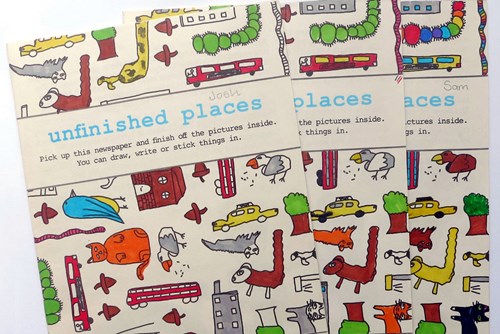
Unfinished Places newspaper produced as part of the artist residencies. Photograph Alison Unsworth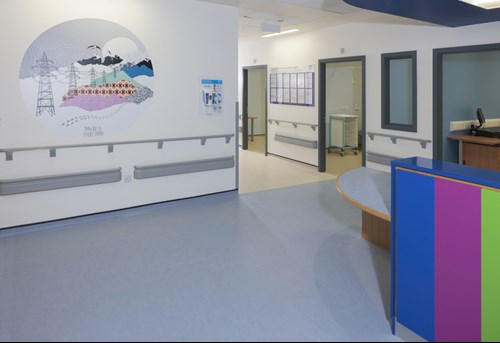
Ian Richards, Graphics integrated into new childrens’ hospital. Photograph Ruth Clark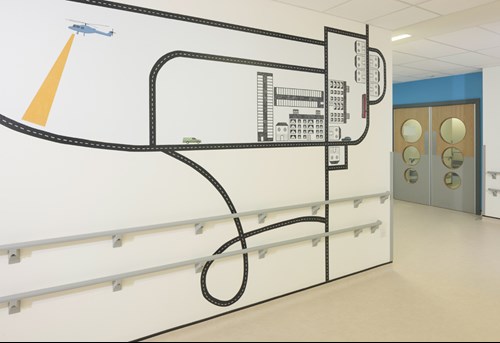
Alison Unsworth, Graphics integrated into new childrens’ hospital. Photograph Ruth Clark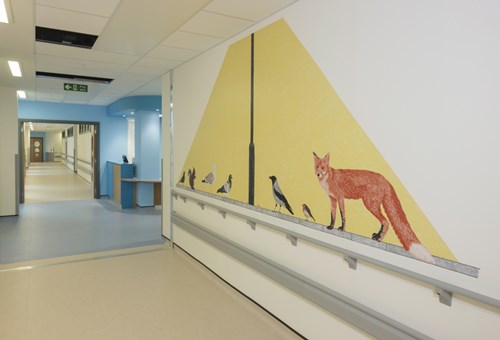
Alison Unsworth, Graphics integrated into new childrens’ hospital. Photograph Ruth Clark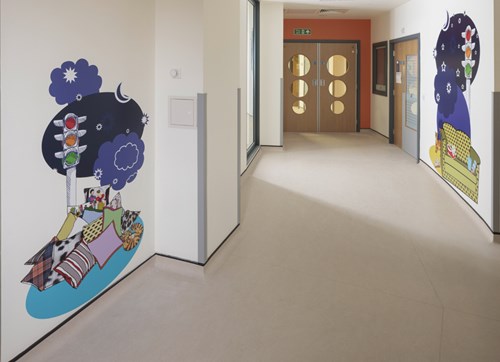
Emma Varley, Graphics integrated into new childrens’ hospital. Photograph Ruth Clark
The Dignified Spaces team was led by Alex Hamilton and included Fremi Arts – art commissioning and curatorship, Catalog Design – interior design, Jane McKie – creative writing, Anna Channing – medical herbalist, Marco Scerri – visual communication, Hannah Brackston – green spaces research. Nicola Murray developed the wallpaper and textile design which was then delivered by Teal Furniture Ltd.
Up to eighty quiet rooms were considered and enhanced as part of the core project. The rooms are used for a range of purposes of which the most important are conversations between clinical, nursing or spiritual care staff and patients’ relatives and carers. On a practical level the rooms need to be comfortable, safe and quiet; they also need to convey that users of the rooms are being treated with dignity.
The team worked with an art and design palette, including lighting, wall colours and coverings, flooring, furniture and artworks. The project used creative community engagement strategies to inform thinking about the idea of dignity and the development of innovative approaches to interiors.
The approach was to seek connections with nature, this approach can be called biophilic design.
Hamilton and his team settled on the metaphor of walled garden to inform the design process.
To drive the biophilic design, a process of creative engagement was undertaken. The community workshops and clinical conversations involved individuals aged from four to seventy, exploring ways of considering all aspects of dignity, including how to listen, and what helps listening in clinical settings.
The workshop activity, held at Hidden Gardens, Glasgow, involved participants looking at the plants within the walled garden, selecting leaves and petals with which they made their own image using the cyanotype process. Cyanotype photography provided a direct and immediate method for image making. These pictures helped to inform the design process, wallpaper, fabric for chairs, and the overall aesthetic used in the Quiet Rooms.
Through close collaboration with Teal a unique fabric design was developed and applied to standard furniture for each of the rooms. This fabric range is now an available product within the Teal range.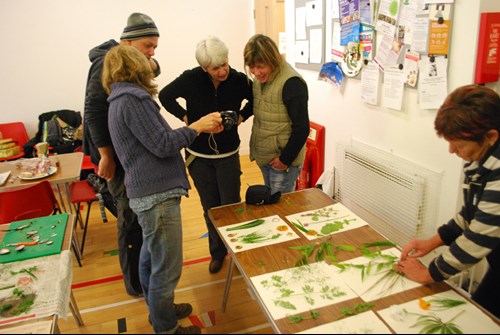
Alex Hamilton, Cyanotype workshop at the Hidden Gardens. Photograph Alex Hamilton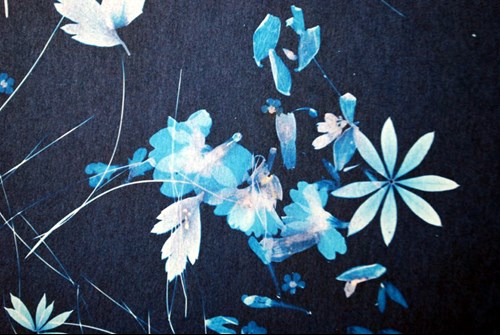
Alex Hamilton, Cyanotype print produced from workshops. Photograph Alex Hamilton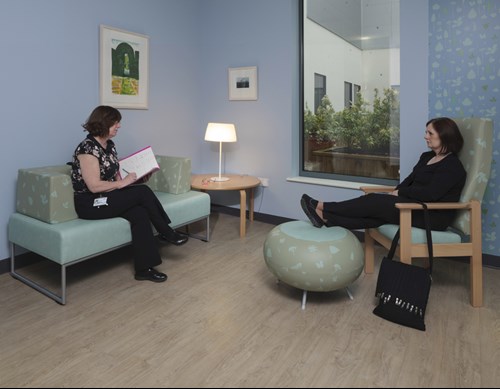
Alex Hamilton, Dignified Spaces quiet room. Photograph Ruth Clark
www.alexanderhamilton.co.uk
The 100 Flowers project is a response to the restriction of real flowers in acute hospitals, due to infection control measures, and is designed to put flowers back at the heart of the experience of the new hospitals.
The iconic image in the collection is a photograph taken by a member of staff. It’s of a small group of daffodils in the grounds of the Southern General. Craig Humanuth, the member of NHSGGC staff who took the photograph, commented that these are the only flowers he sees during his working day. In the background you can just make out the new Hospitals reflected in the windows of the old one.
The 100 Flowers project has produced a hundred new works of art of flowers in the New South Glasgow Hospitals in waiting rooms and departments to be enjoyed by patients, families, carers, visitors and staff alike.
It has been an opportunity for artists, staff, community groups to create new works using flowers.
The collection aims to reflect the rich diversity, not just in the flowers that can be found in and around the hospital, but the people and staff who will use and work in the new facility.
Three local arts organisations, Plantation Productions, Art in Hospital and Govan Youth Café, were asked to work with older people, young people and people with different cultural backgrounds living in the Southside of Glasgow.
There was an Open Call enabling anyone to propose a work for the Collection, and also three artists were commissioned to make groups of work for the Collection.
The 100 Flowers Project has been developed in partnership with Glasgow Life, the Hunterian Museum and Art Gallery and the CCA.
There will be a book published of all the works in the Collection, available for purchase in the Hospitals and in City museums, arts centres and shops. In addition NSGH Staff will be able to request that reproductions of the pictures from the 100 Flowers Collection are hung in areas that they work.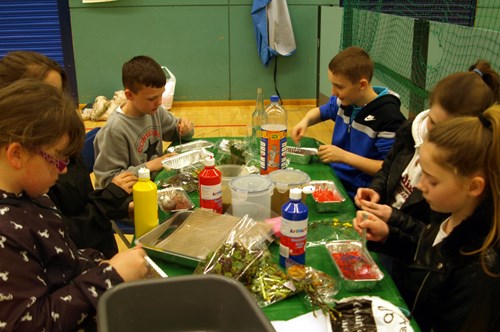
100 Flowers workshop in Govan, Govan Youth Cafe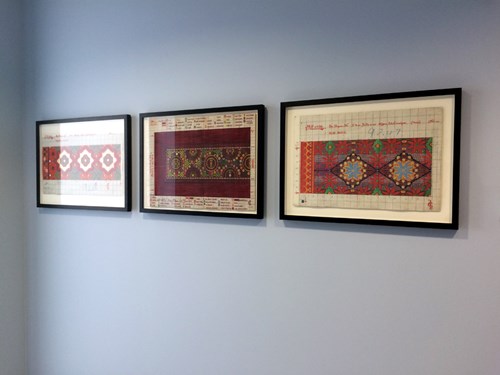
James Winnett, Part of the 100 Flowers Collection. Photograph Tom Littlewood
A film of the 100 Flowers Collection can be viewed below or please click on the following links to view the collection in full:
Image set 1 / Image set 2 / Image set 3 / Image set 4 / Image set 5
Jephson Robb and Peter Richardson of ZM Architecture have designed three Pavilions and two bicycle shelters. All the structures reinforce the external way finding strategy being placed as key landmarks. The structures benefitted from significant additional funding from the Yorkhill Children’s Charity.
The Pavilions and Shelters are positioned as stopping points on journeys. Just going into hospital for an outpatient appointment or to visit someone can be stressful. The Pavilions and Shelters support that journey. When you sit in one of these pavilions and shelters and look up, day or night, you’ll see the pattern of the night sky. For a moment, you’ll be transported from your everyday context to somewhere magical.
When children visit the pavilion in the Children’s Park they’ll find a performance space where they can take the limelight. A spotlight on sensor activation will put them centre stage. Parents and carers can watch their children invent new stories or moves.
The two bike shelters and Garden and Play pavilions will be erected during 2015 with the final Orchard Pavilion planned for 2016.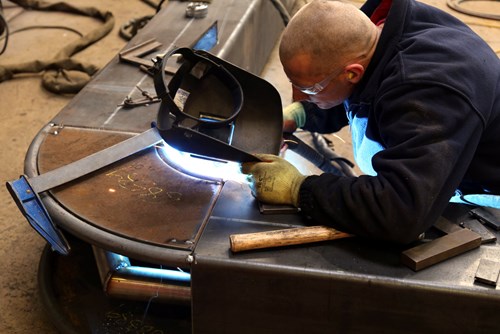
Jephson Robb and ZM Architecture, Bicycle shelters in fabrication at M&S Steel. Photograph Mike Bolam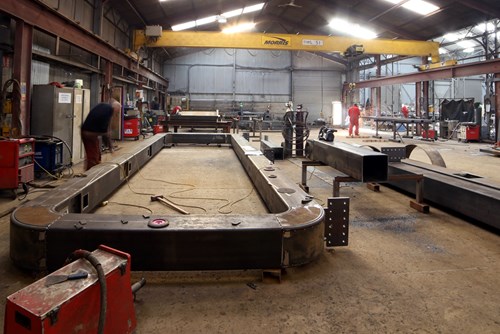
Jephson Robb and ZM Architecture, Bicycle shelters in fabrication at M&S Steel. Photograph Mike Bolam
Spinning Gold – Art and Architecture Programme
Context
The redeveloped Maternity Unit and new Neonatal extension within SGH campus brings together for the first time in Glasgow, Neonatal, Medical and Surgical Intensive Care. The facility will include a new state-of-the-art labour suite and two obstetric theatres plus a separate Fetal Medicine department, providing specialist diagnostic facilities and treatment to unborn babies.
The art and architecture programme for the Southern General Maternity unit was commissioned in October 2008 during the final stages of completion of the new Neonatal extension. Lead Artist partnership Koan3 worked in collaboration with an Art & Therapeutic Design sub management group – including Neonatal clinicians, Maternity staff and a key Planning manager- set up within the management structure of the Maternity Project Board. Koan3 also liaised with the project architect in developing a colour logic for the internal spaces to aide wayfinding throughout the new Neonatal building.
Concept
The conceptual approach and subsequent art projects were in the most part, shaped by the invaluable input received during ‘drop in’ sessions organised for staff and service users to give feedback, thoughts and suggestions on what they felt was essential in creating a therapeutic environment which would enhance the individual experience of the maternity environment.
‘The Journey’ emerged as a key underlying theme for the ‘Spinning Gold’ art programme which encompassed both the physical and emotional aspects of the Maternity experience within the building. From the mother’s arrival pre delivery to waiting to be admitted, her migration through the building to getting settled and prepared to give birth.
Koan3 identified key zones on this route which presented opportunities for artworks to provide a more personal and reassuring environment; helping to reduce confusion and anxiety by improving the individual experience of arrival, wayfinding and waiting for service users. The artworks make subtle references to nature and the celebration of life.
Spinning Gold – art programme in progress
Five artists were selected and appointed through an application process led by Koan3. Each undertook a project plotted along the Maternity ‘route’ within the unit as follows:
Main Maternity Entrance Artworks
Commissioned Artist:
The Flowerers – takes inspiration from the exquisite embroidery of the Ayrshire muslin ‘Flowerers’. Their use of symbols of purity and elegance is given a contemporary twist through the use of colour and modular patterns created solely by intersecting circles produced on translucent glazing film.
Meadow Wall -seven individual hexagonal wooden panels wall mounted opposite the reception area and aligned with each other in keeping with the flowerers modular pattern.
Lobby Access Lift Areas Artwork : Petals
Commissioned Artist:
Petals –The ceiling artwork uses natural geometries to form a visual language that balances femininity with science. A collection of three – dimensional ‘petal’ forms which are derived from a basic hexagon, each rotates in six directions to form a seemingly random scattering which encourages the eye along the route connecting to the main corridor.
Main Maternity Corridor Artwork: Colour Sentences
Commissioned Artist:
Colour Sentences – is a linear installation of shallow lightboxes which layer delicate plant imagery with sequenced ‘bands’ of developing colour to draw the eye along the main Maternity Corridor emphasising the transitional nature of this space.
Maternity Night Entrance: Strands
Commissioned Artist: Tony Stallard
Strands – a site-specific light sculpture in neon, designed to suggest DNA or RNA strands connecting the space, this ‘joining’ or ‘coupling’ by way of ‘strands’ suggest a symbolic reference to the biological link between Mother and child as well as the physical linking of spaces between the Maternity buildings in an architectural sense.
Neonatal Waiting Rooms: River of Names ( interactive Digital)
Commissioned Artist: Nicola Gear
River of Names – an interactive digital artwork for the monitors in the Neonatal waiting rooms. Visitors are able to touch the image of flowing water on the screens to hear the voices of local people telling stories and sharing memories surrounding the subject of naming a child.
Neonatal Main stairwell : Sonar Landscapes
Lead Artist: Koan3
Sonar Landscapes is intended as a wayfinding artwork which ‘flows down through all three floors of the Neonatal unit stairwell. Each section houses a small portal window at the centre, softly lit and encompassing a miniature landscape themed to correspond to the level of energy and emotion on that particular floor.
Neonatal Roof Terrace: Garden of Contemplation
Lead Artist: Koan3
Garden of Contemplation – an ornamental ‘viewing garden’ on the roof terrace over looked by the Special Care Baby Unit and potentially the new Children’s Hospital. The design focuses on a contemplative space, which incorporates visual poetry/typography etched onto delicately coloured glass panels; intended to evoke pauses in time and moments captured between thoughts it offers a peaceful focus for visitors.
Lead Artist Curator: Koan3 (Artists Callum Sinclair & Lorraine Aaron)
Architects: Hypostyle
Funders: Grant funding £200,000 received from Yorkhill Children’s Foundation
Contributions from Women & Children’s Directorate
Key Dates: Appointment of Lead Artist – Oct 2008
Art programme Install begins – July 2010
Expected Completion – Most artworks by Oct 2011
Two projects affected by Maternity Refurb timeline.
NHSGGC Arts and Health programmes aim to create safe and welcoming environments and positive experiences for patients, visitors and staff. An integrated approach considers the ways in which art, architecture, design, music and nature all have a positive impact on our health.
The evidence-based programmes include public art commissions, creative workshops, and integrated design strategies in buildings and green spaces. The work is inspired by the creative talent of Scotland and developed in collaboration with arts, education, voluntary sector and funding partners.
See below to find out more about the programmes, take a look at the cutting-edge designs for new clinical spaces and find out more about arts in healthcare.
Artwork created by Renfrewshire school children has gone on display to staff and visitors at the Roy…
NHS Greater Glasgow and Clyde (NHSGGC) is proud to announce its partnership with the Mental Health F…
Staff throughout NHS Greater Glasgow and Clyde are to play a starring role in a week-long celebratio…
NHSGGC Arts and Health programmes aim to reduce health inequalities through access to the arts.
The arts have many roles to play in healthcare, enhancing environments, supporting treatment and inspiring conversations that improve services.
The work contributes to our local communities via creative health projects that build relationships and support collaborative working.
Case Study
Black Mother and Baby
This mural is located at the entrance to the Princess Royal Maternity Hospital at the Glasgow Royal Infirmary. It was developed by NHS Greater Glasgow and Clyde, in response to the work of campaigner Rachel Dallas, to raise awareness of health inequalities in maternity care.
The painting catalysed discussions about maternal health inequalities and contributed to cultural shifts within our organisation.
“It’s not just a mural”
Read more about the project here: Work completes on giant mural at Glasgow Royal Infirmary
Click on the image below to view our Arts and Social Justice gallery on Flickr.

The Animating Public Spaces programme is an innovative, evidence-based initiative designed to enhance healthcare environments. A dynamic programme of performing arts, exhibitions and artist residencies highlights the significant psychological and physiological benefits of arts participation and cultural engagement.
Offering opportunities for emerging and established artists, arts, education, and voluntary sector partners, the programme aims to showcase creative work in healthcare environments. For some people, cultural programming in clinical spaces may provide their only access to the arts, highlighting the importance of this offering.

Our approach to healthcare design involves the integration of public art into the development of green spaces and placemaking, making sustainable green spaces for everyone to enjoy and encouraging safe activity in the open air.
NHSGGC programmes incorporate green space activities in clinical, community and mental health care.

The project ‘waiting room in the park’ opens up a Springburn Park entrance to the New Stobhill Ambulatory Care and Diagnostic Hospital creating an opportunity for patients, staff and visitors to enter through artist Alec Finlay’s Moon Gate sculpture.
Boulders engraved with poetry, bird boxes and benches engage people further, encouraging use of green space, walking and waiting for medical appointments in a natural environment.
This work initiated a shift in thinking that expanded architectural focus beyond the walls of the building to the land surrounding it.
Gardens are a 150-year old tradition at Gartnavel Royal Hospital. Art in the Gart seeks to make the best use of hospital grounds and spaces to support inpatient mental health recovery and wellbeing. The programme includes exhibitions, public art commissions and green space activities.
Gartnavel Royal Hospital has a well-established history of using meaningful activities as part of therapeutic treatment programmes. Thanks to this longstanding commitment to enabling creative activity and self-expression, the Art in the Gart initiative emerged in 2013.
Art in the Gart finds its inspiration in the interests, talents and skills of Gartnavel Royal Hospital patients. Activities are as diverse as each individual. The programme grows with each new idea gifted by participants and develops year on year.
Art in the Gart harnesses expertise in the arts and creative media by drawing on the skills and goodwill of volunteers and long-term contacts in education, professional and community arts as well as Third Sector partnerships such as Common Wheel and Project Ability.
This mode of working has contributed to a high-quality hospital experience for our patients. Skilled volunteers enable patient participation and access to a wide range of activities including art workshops across all media, which can be exhibited in the Art in the Gart Gallery Space.
This trailblazing programme has inspired the creation of similar initiatives in mental health settings including Design in the Dale, Levendale Hospital and Stobhill.
Click on the image below to view our Art and Green Spaces gallery on Flickr.

The aim of this work is to modernise services and improve health through integrated art and design strategies within new buildings, green spaces and refurbishments. Artists work collaboratively with architects and stakeholders in order to improve the environment.
We commission artists to contribute works for permanent installation in our clinical spaces and surrounding green spaces.
Case Studies – Therapeutic Design
Dignified Spaces
Dignified Spaces: Supporting conversations was one of six commissioned projects for the new South Glasgow University Hospital and Royal Hospital for Sick Children.
More than eighty quiet rooms were enhanced as part of the project, using principles of biophilic design to enhance wellbeing. These rooms are used for a range of purposes, of which the most important are conversations between clinical, nursing or spiritual care staff and patients’ relatives and carers.
Find out more: https://www.nicolamurray.com/work/case-studies/nsgh-dignified-spaces/
https://www.artinscotland.tv/2015/dignified-spaces-project/
100 Flowers
100 Flowers is an art collection curated by Clare Phillips on behalf of Ginkgo Projects for NHS Greater Glasgow & Clyde’s new South Glasgow University Hospital and Royal Hospital for Sick Children.
Over 70 artists contributed by making works for the collection, which is installed across the new buildings.
Some other examples of our Health by Design initiatives:

Art in Hospital delivers a comprehensive and ongoing visual arts programme across a wide range of healthcare settings in Glasgow and throughout Scotland.
Originally focused on long-term care for older adults, the programme has expanded to support individuals in rehabilitation and assessment units, those with life-limiting illnesses, young people with physical disabilities, mental health service users, outpatients, and patients undergoing rheumatology treatment, renal dialysis, or palliative care. Through creative engagement, Art in Hospital enhances well-being, self-expression, and the overall healthcare experience.
The positive impact of creative and performing arts on health and wellbeing is demonstrated by numerous projects across Glasgow and Scotland. These projects bring together professional artists and local community organisations working with a range of media including drawing and painting, digital photography, textiles, video, printmaking, music and drama.
Please see the links below to find out more about creative health initiatives, organisations and research.
The Buddy Beat
A Renfrewshire drumming group for adults with mental health experience, aimed at promoting social inclusion and helping people self-manage their week.
Culture Health & Wellbeing Alliance
Arts, Culture, Health & Wellbeing, Scotland (ACHWS)
ACHWS has developed into an active Scotland-wide network providing information and support for anyone working across arts and culture, health and wellbeing. It is a collective voice for arts and health in Scotland.
MacDonald, Raymond AR (2013)
Music, health and wellbeing: a review International Journal of Qualitative Studies in Health and Wellbeing
Common Wheel A charity that supports people managing or recovering from mental illness and dementia by providing meaningful activities.
Scottish Health Equity Research Unit (SHERU)
Leave No One Behind (2023) Report on the state of health and health inequalities in Scotland: https://www.health.org.uk/sites/default/files/upload/publications/2023/HF_Health_Scotland_Web_Final.pdf
Project Ability Creating opportunities through inclusive art for all, providing a welcoming arts community for people with learning disabilities and mental ill-health.
Glasgow Medical Humanities Network
Scottish Mental Health Arts Festival
British Association of Art Therapists
Evidence summary for policy: The role of arts in improving health and wellbeing (2020)
Creative Scotland Arts and Health Map (2021) https://www.creativescotland.com/binaries/content/assets/creative-scotland/resources-and-publications/research/2022/creative-scotland-arts-and-health-mapping-report.pdf